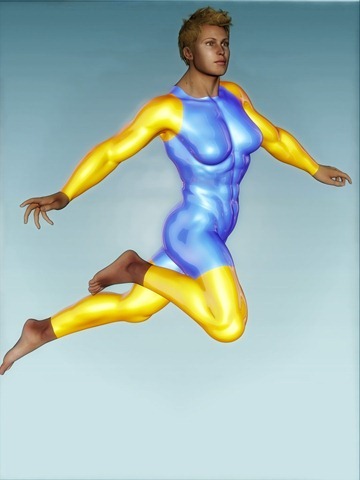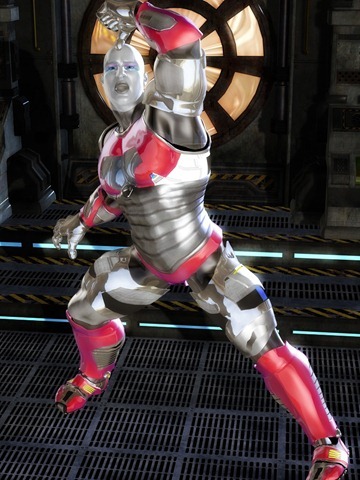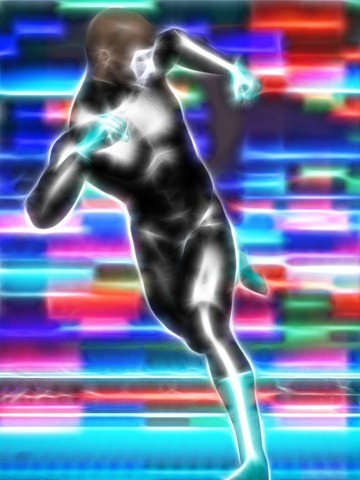So you want to be a superhero gamer. You want to run, punch and fly faster, harder and further than ever before. You tire of being constrained by mere dungeons and battlemats, and want to create a character that is entirely the product of your own imagination, not the sum of race plus class. You want a system that doesn’t skimp on the details yet is fast and fun to play, a game that really does make you feel like you are the hero.
In short, you want to play Mutants & Masterminds Third Edition. You just don’t know it yet.
Perhaps you have played in a superhero role-playing game before – maybe even Second Edition Mutants & Masterminds – and are tempted to take a look at Third Edition Mutants & Masterminds or DC Adventures. They are the same system but the latter contains information and details about the DC Universe as a complete ready-made campaign setting. Rules-wise, they’re identical.
What we’re going to do is take a look at Superhero Gaming as a whole – what makes it special and things to watch out for if you’re more accustomed to fantasy role-playing – then move on to how to get started with M&M 3e itself.
So strap on your rocket boots, shout Kimota or run to the nearest telephone box to change. We’re about to enter the world of the Superhero Gamer!
If you are accustomed to fantasy role-playing games, one of the biggest shifts when you step into the superhero genre is one of scale. You’re going from a genre where everyone has roughly the same speed (give or take a 5′ step), and the strongest hero in your group can lift about 400lds to one where some heroes will be able to run (or fly) around the world in a single round or lift thousands of tons. This is a genre where anything goes – reanimated WWII soldiers can rub shoulders with immortal cavemen and shape-shifting aliens. Your hero may well have normal human strength, but he might be able to shoot laser beams from his eyes, teleport or become intangible with but a thought.
This means that conflicts can be larger than will fit on a mere battlemat, and your superheroes will have to watch out for collateral damage. Punching a villain through a skyscraper might be fun, but make sure it is vacant first. Remember that lawyers are everyone’s kryptonite.
One of the unspoken tenets of superhero hero role-playing is this: No one can do everything. More than any other genre, superhero gaming is all about being a part of a team. It is about having a team name and a secret (or not so secret) headquarters. It is about wearing your spandex uniform with pride. Even if your hero can fly faster than a speeding bullet, take a direct hit from a rocket and punch like a freight train, you’re still going to need someone who can attack at range, wield magic or possess cool ninja tech.
Some super-groups work best when they’re built as a team from the ground up. If you can, have all the players create their heroes at the same time all based around a common origin or concept. This gives you a ready-made reason for them working together as well as a chance to run their origin as your first scenario!
The Fantastic Four are a great example of a shared origin and group dynamics. The superheroes are based around the four elements (Earth, Air, Fire and Water for those at the back) and all gained their powers at the same time due to exposure to cosmic rays. Collectively, their powers neatly cover all the bases though individually the heroes are weak in one or more areas.
The other type of group is the superhero team up. This throws heroes together because they all share some common power source (The X-Men), are roughly the same age (Teen Titans), are a family (The Incredibles), all live in the same area (East Coast Avengers) or are simply the best at what they do (Justice League). In your own campaign setting the superheroes could be the only ones of their kind, be reformed super-villains or anything else you can come up with. It’s worth coming up with a reason for the group’s existence as soon as possible as this helps reinforce the team spirit that is so central to a good multi-player superhero game.
The flipside of the coin is solo gaming, and here superhero gaming also excels. Who doesn’t want to play the lone avenger once in a while? Running a superhero game with just one player and GM puts that one superhero entirely in the spotlight and gives him a chance to really shine. This could either be a character designed for a solo game from the start, or a hero from a group given a little airtime. Unlike fantasy gaming where it’s rare for one of the party to have a solo side-trek, when it comes to superhero RPGs you can run a solitaire adventure at the drop of a hat. Maybe your hero is on patrol duty around Super City, or is pursuing their own goals. This is a common enough trope in the comics where members of the Justice League have their own stand alone comic title, so why not use it in your game too?
Then there’s the Superhero who always works alone. If you have only one other gamer in your vicinity or want to introduce the game to a new player without all that peer pressure, this is an ideal way to play. Remember that unlike building a hero for a super team, your built-for-solo Superhero will need to be capable in many areas, but don’t sweat the details too much. A wise DM will build the adventure around the superhero’s strengths and style. It’s rare, for example, for Batman to face off against magical villains or Superman to go busting gangsters by Pier Thirteen.
Which leads us, in a roundabout way, to character generation. And that’s what we’ll talk about – next time.







Lair: A Beginners Guide to Superhero Gaming, Part One http://t.co/4fhtE8EP #rpg
This is a great start. Looking forward to part two. Thanks as well to the fantastic art within.
A beginner’s guide to superhero gaming, part one http://t.co/uCIYeEQa (via @greywulf)
A Beginners Guide to Superhero Gaming, Part One from Greywulf’s Lair » RPG http://t.co/I1pmf9lc #RPG